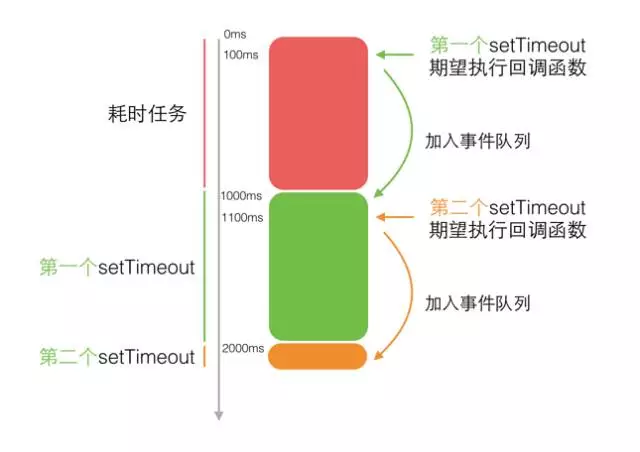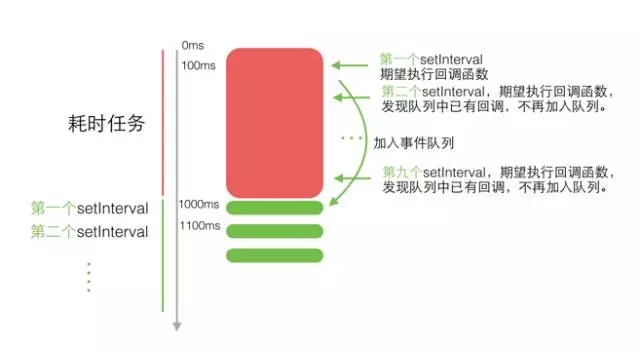How javascript timer works
When talking about timers in javascript, we will definitely think of the two functions setTimeout() and setInterval(). This article will analyze the working principles and differences between the two from the perspective of event loop.
setTimeout()
MDN defines setTimeout as:
Call a function or execute a code fragment after the specified delay time.
Syntax
The syntax of setTimeout is very simple. The first parameter is the callback function, and the second parameter is the delay time. The function returns a unique ID of numeric type. This ID can be used as a parameter of clearTimeout to cancel the timer:
var timeoutID = window.setTimeout(code, delay);
IE0+ also supports the passing of callback parameters:
var timeoutID = window.setTimeout(func, delay, [param1, param2, ...]);
setInterval()
MDN defines setInterval as:
Periodically call a function (function) or execute a piece of code.
Since the usage of setInterval and setTimeout are the same, they are not listed here anymore.
Explanation of the second parameter (delay)
Due to the event loop mechanism of JavaScript, the second parameter does not mean that the callback function will be executed immediately after delay milliseconds, but it will try to The callback function is added to the event queue. In fact, there is a difference in the processing between setTimeout and setInterval at this point:
setTimeout: After the delay milliseconds, no matter what, the callback function is directly added to the event queue.
setInterval: After the delay milliseconds, first check whether there is a callback function in the event queue that has not yet been executed (the callback function of setInterval). If it exists, do not add a callback function to the event queue.
Therefore, when there are time-consuming tasks in our code, the timer will not behave as we think.
Let’s understand through an example
The following code originally hoped to be able to call the callback function at 100ms and 200ms (that is, just waiting for 100ms):
var timerStart1 = now();
setTimeout(function () {
console.log('The first setTimeout callback execution waiting time:', now() - timerStart1);
var timerStart2 = now( );
setTimeout(function () {
console.log('Second setTimeout callback execution waiting time:', now() - timerStart2);
}, 100);
}, 100);
// Output:
// Waiting time for the first setTimeout callback execution: 106
// Waiting time for the second setTimeout callback execution: 107
Like this The result looks like what we expected, but once we add time-consuming tasks to the code, the result is not what we expected:
var timerStart1 = now();
setTimeout(function () {
console.log('First setTimeout callback execution waiting time:', now() - timerStart1);
var timerStart2 = now();
setTimeout(function () {
console.log('Second setTimeout callback execution waiting time:', now() - timerStart2);
}, 100);
heavyTask() ; // Time-consuming task
}, 100);
var loopStart = now();
heavyTask(); // Time-consuming task
console.log('heavyTask takes time :', now() - loopStart);
function heavyTask() {
var s = now();
while(now() - s < 1000) {
}
}
function now () {
return new Date();
}
// Output:
// heavyTask time consumption: 1015
// The first setTimeout callback execution waiting time: 1018
// The second setTimeout callback execution waiting time: 1000
The waiting events of the two setTimeout are no longer 100ms due to the existence of time-consuming tasks. Got it! Let's describe what happened:
First, the first time-consuming task (heavyTask()) starts to execute, and it takes about 1000ms to complete.
Start executing the time-consuming task. After 100ms, the first setTimeout callback function is expected to be executed, so it is added to the event queue. However, the previous time-consuming task has not yet been executed, so it only It can wait in the queue and it will not start execution until the time-consuming task is completed, so what we see in the result is: The first setTimeout callback execution waiting time: 1018.
As soon as the first setTimeout callback is executed, the second setTimeout is started. This timer is also expected to execute its callback function after a delay of 100ms. However, there is another time-consuming task in the first setTimeout. Its plot is the same as that of the first timer, and it also waits for 1000ms before starting execution.
It can be summarized by the following picture:

Let’s look at an example of setInterval:
var intervalStart = now();
setInterval(function () {
console.log('interval The time since the timer was defined: ', now() - loopStart);
}, 100);
var loopStart = now();
heavyTask();
console.log ('heavyTask takes time:', now() - loopStart);
function heavyTask() {
var s = now();
while(now() - s < 1000) {
}
}
function now () {
return new Date();
}
// Output:
// heavyTask time consumption: 1013
// interval time from the defined timer: 1016
// interval time from the defined timer: 1123
// interval time from the defined timer: 1224
In the above code, we expect to print a log every 100ms. Compared with setTimeout, setInterval will determine whether there are unexecuted callbacks in the queue when preparing to add the callback function to the event queue. If so, it will not add the callback function to the queue. Otherwise, multiple callbacks will be executed at the same time.
It can be summarized by the following diagram:

Summary
The above is a brief analysis of the JavaScript timer execution principle. Hope it can help us understand javascript more deeply. If there are inappropriate descriptions in the article, please point them out in the comments.
For more articles related to the working principle of javascript timer, please pay attention to the PHP Chinese website!

Hot AI Tools

Undresser.AI Undress
AI-powered app for creating realistic nude photos

AI Clothes Remover
Online AI tool for removing clothes from photos.

Undress AI Tool
Undress images for free

Clothoff.io
AI clothes remover

AI Hentai Generator
Generate AI Hentai for free.

Hot Article

Hot Tools

Notepad++7.3.1
Easy-to-use and free code editor

SublimeText3 Chinese version
Chinese version, very easy to use

Zend Studio 13.0.1
Powerful PHP integrated development environment

Dreamweaver CS6
Visual web development tools

SublimeText3 Mac version
God-level code editing software (SublimeText3)

Hot Topics
 Replace String Characters in JavaScript
Mar 11, 2025 am 12:07 AM
Replace String Characters in JavaScript
Mar 11, 2025 am 12:07 AM
Detailed explanation of JavaScript string replacement method and FAQ This article will explore two ways to replace string characters in JavaScript: internal JavaScript code and internal HTML for web pages. Replace string inside JavaScript code The most direct way is to use the replace() method: str = str.replace("find","replace"); This method replaces only the first match. To replace all matches, use a regular expression and add the global flag g: str = str.replace(/fi
 8 Stunning jQuery Page Layout Plugins
Mar 06, 2025 am 12:48 AM
8 Stunning jQuery Page Layout Plugins
Mar 06, 2025 am 12:48 AM
Leverage jQuery for Effortless Web Page Layouts: 8 Essential Plugins jQuery simplifies web page layout significantly. This article highlights eight powerful jQuery plugins that streamline the process, particularly useful for manual website creation
 Build Your Own AJAX Web Applications
Mar 09, 2025 am 12:11 AM
Build Your Own AJAX Web Applications
Mar 09, 2025 am 12:11 AM
So here you are, ready to learn all about this thing called AJAX. But, what exactly is it? The term AJAX refers to a loose grouping of technologies that are used to create dynamic, interactive web content. The term AJAX, originally coined by Jesse J
 10 Mobile Cheat Sheets for Mobile Development
Mar 05, 2025 am 12:43 AM
10 Mobile Cheat Sheets for Mobile Development
Mar 05, 2025 am 12:43 AM
This post compiles helpful cheat sheets, reference guides, quick recipes, and code snippets for Android, Blackberry, and iPhone app development. No developer should be without them! Touch Gesture Reference Guide (PDF) A valuable resource for desig
 Improve Your jQuery Knowledge with the Source Viewer
Mar 05, 2025 am 12:54 AM
Improve Your jQuery Knowledge with the Source Viewer
Mar 05, 2025 am 12:54 AM
jQuery is a great JavaScript framework. However, as with any library, sometimes it’s necessary to get under the hood to discover what’s going on. Perhaps it’s because you’re tracing a bug or are just curious about how jQuery achieves a particular UI
 10 jQuery Fun and Games Plugins
Mar 08, 2025 am 12:42 AM
10 jQuery Fun and Games Plugins
Mar 08, 2025 am 12:42 AM
10 fun jQuery game plugins to make your website more attractive and enhance user stickiness! While Flash is still the best software for developing casual web games, jQuery can also create surprising effects, and while not comparable to pure action Flash games, in some cases you can also have unexpected fun in your browser. jQuery tic toe game The "Hello world" of game programming now has a jQuery version. Source code jQuery Crazy Word Composition Game This is a fill-in-the-blank game, and it can produce some weird results due to not knowing the context of the word. Source code jQuery mine sweeping game
 How do I create and publish my own JavaScript libraries?
Mar 18, 2025 pm 03:12 PM
How do I create and publish my own JavaScript libraries?
Mar 18, 2025 pm 03:12 PM
Article discusses creating, publishing, and maintaining JavaScript libraries, focusing on planning, development, testing, documentation, and promotion strategies.
 jQuery Parallax Tutorial - Animated Header Background
Mar 08, 2025 am 12:39 AM
jQuery Parallax Tutorial - Animated Header Background
Mar 08, 2025 am 12:39 AM
This tutorial demonstrates how to create a captivating parallax background effect using jQuery. We'll build a header banner with layered images that create a stunning visual depth. The updated plugin works with jQuery 1.6.4 and later. Download the






